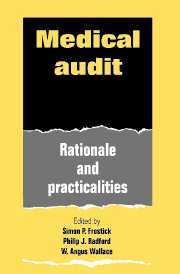Book contents
- Frontmatter
- Contents
- List of contributors
- Foreword
- Foreword
- 1 Introduction
- 2 Audit: historical and future perspectives
- 3 Audit philosophy
- 4 Medical audit: a view from the centre
- 5 Audit: a view from the Royal College of Surgeons of England
- 6 The regional viewpoint
- 7 Medical audit: the needs of the District Health Authorities
- 8 Resource management and budget holding
- 9 Unit and district information systems
- 10 Read codes and medical audit
- 11 Data capture direct from doctors
- 12 Computer systems: practice, limitations and pitfalls
- 13 Paediatric audit
- 14 Audit in obstetrics and gynaecology
- 15 Audit in general surgery
- 16 Orthopaedic audit: guidelines and hints
- 17 Installing audit in general practice and general dental practice
- 18 Clinical audit in psychiatry. Models for audit in mental health
- 19 Audit in anaesthesia
- 20 Audit in intensive care
- 21 Medical audit: lessons from the USA
- 22 Quality control in health care: the Dutch experience
- 23 Medical audit: experience from Sweden
- 24 Performance indicators
- 25 Measuring outcome and quality control
- 26 Audit: will it work?
- 27 What has been achieved so far?
- 28 A practical guide to audit
- Index
14 - Audit in obstetrics and gynaecology
Published online by Cambridge University Press: 30 September 2009
- Frontmatter
- Contents
- List of contributors
- Foreword
- Foreword
- 1 Introduction
- 2 Audit: historical and future perspectives
- 3 Audit philosophy
- 4 Medical audit: a view from the centre
- 5 Audit: a view from the Royal College of Surgeons of England
- 6 The regional viewpoint
- 7 Medical audit: the needs of the District Health Authorities
- 8 Resource management and budget holding
- 9 Unit and district information systems
- 10 Read codes and medical audit
- 11 Data capture direct from doctors
- 12 Computer systems: practice, limitations and pitfalls
- 13 Paediatric audit
- 14 Audit in obstetrics and gynaecology
- 15 Audit in general surgery
- 16 Orthopaedic audit: guidelines and hints
- 17 Installing audit in general practice and general dental practice
- 18 Clinical audit in psychiatry. Models for audit in mental health
- 19 Audit in anaesthesia
- 20 Audit in intensive care
- 21 Medical audit: lessons from the USA
- 22 Quality control in health care: the Dutch experience
- 23 Medical audit: experience from Sweden
- 24 Performance indicators
- 25 Measuring outcome and quality control
- 26 Audit: will it work?
- 27 What has been achieved so far?
- 28 A practical guide to audit
- Index
Summary
Introduction
The basic ideas of ‘Health for All by the Year 2000’ were outlined in 1978 at the Alma Ata Conference organised by the World Health Organisation (WHO) and the United Nations Children's Fund (UNICEF). Subsequently, the WHO Regional Office for Europe devised criteria to monitor some practical ways of implementing the basic ideas and in their document they suggest ‘By 1990, all members states should have built effective mechanisms for ensuring the quality of care within their health care systems’. Medical audit is one way of monitoring the mechanisms implemented to ensure the quality of care and indeed, medical audit is a key part of the UK's White Paper that proposed reconstruction of the National Health Service.
Maternal mortality audit
Maternal mortality audit is not a new phenomenon in the specialty of obstetrics and gynaecology. In Scotland, for example, the first special enquiry into maternal deaths was instituted in 1930 by agreement between the Scottish Board of Health, the local authorities and the medical professional organisations. The perinatal mortality rate was first recorded in Scotland in 1939, when it was 68 per 1000 total births. The information elicited by the first enquiry led directly to the Maternity Services (Scotland) Act of 1937 and laid the foundation for the immeasurably improved hospital services of today.
- Type
- Chapter
- Information
- Medical Audit , pp. 187 - 200Publisher: Cambridge University PressPrint publication year: 1993

